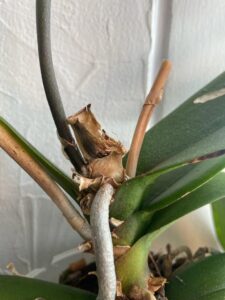Cattleyas are known for their spectacular and large flowers, which can measure up to 25 cm in diameter. They come in various bright and vibrant colors and often emit fragrances. However, their flowering period lasts around 15 days, depending on the species. There are approximately 100 different species of Cattleyas, including our national flower, Cattleya trianae, along with numerous hybrids.
Caring for these exotic plants is not a difficult task. Here are the basic cultivation conditions for Cattleyas:
1. Check the Plant’s Health:
Just like with other orchids, a healthy Cattleya is better equipped to produce and sustain flowers. Examine the following aspects to determine your plant’s health:
– Leaves: Healthy Cattleyas have bright green leaves. Darker leaves indicate too much shade, while pale yellow leaves with black spots or blisters suggest excessive sun exposure.
– Roots: Healthy roots are growing and appear white to grayish. Dehydrated roots become wrinkled, and roots suffering from toxicity might turn purple.
– Pseudobulb: Cattleyas consist of pseudobulbs that store water and nutrients, akin to stems. From these pseudobulbs, leaves (unifoliate or bifoliate) and inflorescences with 1 to 10 flowers are produced. To ensure proper flowering, provide support to the pseudobulb with a stake when flower buds are forming within the floral sheath.
2. Lighting:
Cattleyas thrive in good light and require sunlight exposure. You can grow them on a balcony or veranda where they receive sunlight until around 11 a.m. or after midday. However, avoid exposing them to direct midday sun to prevent burns. In very sunny and hot environments, consider providing shade for the plant, ensuring high humidity and proper air circulation.
3. Watering:
Water your Cattleyas generously three times a week, allowing excess water to drain well. During particularly hot and dry days, you might need to water them more frequently, especially if they’re in bloom. Watering in the morning is advised to allow the plant to dry before nighttime, lower temperatures can lead to issues if the plant remains wet.
4. Temperature:
Cattleyas typically grow high on trees, receiving sunlight with cold and humid air circulation. At home, aim to mimic this environment by providing bright light, high humidity, and comfortable temperatures. They prefer warm to intermediate climates (16°C to 30°C or 60°F to 86°F). Most Cattleyas don’t tolerate cold weather well.
5. Humidity and Ventilation:
Cattleyas can be cultivated in environments with some humidity in the air (40% or higher), such as those found in cities like Cali, Barranquilla, or Medellín. Be cautious about excessive humidity, as it can lead to fungal and bacterial issues, as well as root rot. Ensure the planting area has good ventilation to allow water to evaporate properly. Use a coarse-grade substrate like “Orquimedio” and mount the orchid on bark or a tree for proper ventilation.
6. Fertilization:
Caring for orchids requires some technical knowledge, as you need to control the environment (light, temperature, ventilation, and humidity) to create optimal conditions. Additionally, orchids require nutrients to grow strong. Cattleyas, being epiphytic plants, rely on their host trees for support and nutrients. When potted, they need additional fertilization. Our specially formulated fertilizer, “ORQUIABONO” provides a balanced mix of nutrients that orchids need to grow and bloom. Use it once a week, applying 1 tablespoon per gallon (4 liters) during watering. Follow the recommended dosages to avoid root and leaf burn.
As a preventative measure and to enhance fertilizer effectiveness, you can add a teaspoon of PHYSAN or a drop of SUPERTHRIVE to your fertilizer mixture during application. PHYSAN is a disinfectant detergent that prevents diseases and controls algae and moss growth. SUPERTHRIVE contains hormones and vitamins that promote root and bud growth.
*It’s important to repot Cattleyas every two years or when the plant size has increased. Divide them into plants with 4 pseudobulbs and plant them in a coarse-grade substrate like “Orquimedio,” not regular soil.
Remember that this process requires patience, love, and consistency for your orchid to feel comfortable and eventually surprise you with beautiful blooms.
“Orchids aren’t complicated; they’re just a tad different.”
You can purchase the substrate on our website or in our stores in Cali and Ginebra. If you have any questions, you can visit our stores, where our staff can provide more suggestions. Additionally, we have all the necessary accessories for your orchid cultivation, from Orquimedio (substrate) to Orquitutor, decorative bases, Orquiabono, planters, and many other things.





